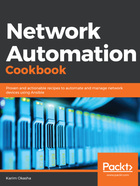
Conventions used
There are a number of text conventions used throughout this book.
CodeInText: Indicates code words in text, database table names, folder names, filenames, file extensions, pathnames, dummy URLs, user input, and Twitter handles. Here is an example: "Mount the downloaded WebStorm-10*.dmg disk image file as another disk in your system."
A block of code is set as follows:
$ cat ansible.cfg
[defaults]
inventory=hosts
retry_files_enabled=False
gathering=explicit
host_key_checking=False
When we wish to draw your attention to a particular part of a code block, the relevant lines or items are set in bold:
- name: Configure ACL on IOS-XR
hosts: all
serial: 1
tags: deploy
tasks:
- name: Backup Config
iosxr_config:
backup:
when: not ansible_check_mode
- name: Deploy ACLs
iosxr_config:
src: acl_conf.cfg
match: line
when: not ansible_check_mode
Any command-line input or output is written as follows:
$ python3 -m venv dev
$ source dev/bin/activate
Bold: Indicates a new term, an important word, or words that you see onscreen. For example, words in menus or dialog boxes appear in the text like this. Here is an example: "Select System info from the Administration panel."